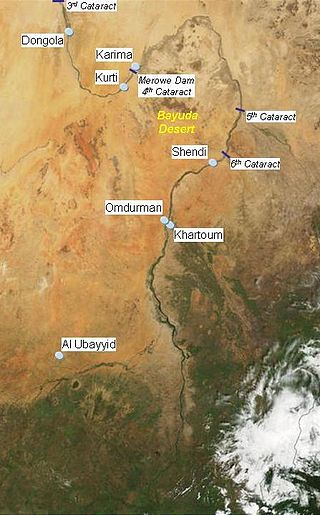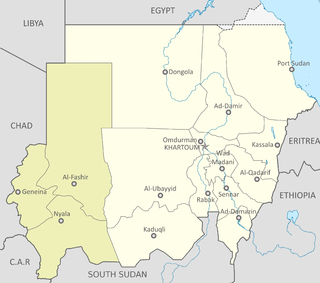Related Research Articles

Sudan, officially the Republic of the Sudan, is a country in Northeast Africa. It borders the Central African Republic to the southwest, Chad to the west, Egypt to the north, Eritrea to the northeast, Ethiopia to the southeast, Libya to the northwest, South Sudan to the south, and the Red Sea to the east. It has a population of nearly 50 million people as of 2024 and occupies 1,886,068 square kilometres, making it Africa's third-largest country by area and the third-largest by area in the Arab League. It was the largest country by area in Africa and the Arab League until the secession of South Sudan in 2011; since then both titles have been held by Algeria. Its capital and most populous city is Khartoum.

The history of Sudan refers to the territory that today makes up Republic of the Sudan and the state of South Sudan, which became independent in 2011. The territory of Sudan is geographically part of a larger African region, also known by the term "Sudan". The term is derived from Arabic: بلاد السودان bilād as-sūdān, or "land of the black people", and has sometimes been used more widely referring to the Sahel belt of West and Central Africa.
Nubians are a Nilo-Saharan speaking ethnic group indigenous to the region which is now northern Sudan and southern Egypt. They originate from the early inhabitants of the central Nile valley, believed to be one of the earliest cradles of civilization. In the southern valley of Egypt, Nubians differ culturally and ethnically from Egyptians, although they intermarried with members of other ethnic groups, especially Arabs. They speak Nubian languages as a mother tongue, part of the Northern Eastern Sudanic languages, and Arabic as a second language.

Darfur is a region of western Sudan. Dār is an Arabic word meaning "home [of]" – the region was named Dardaju while ruled by the Daju, who migrated from Meroë c. 350 AD, and it was renamed Dartunjur when the Tunjur ruled the area. Darfur was an independent sultanate for several hundred years until 1874, when it fell to the Sudanese warlord Rabih az-Zubayr. The region was later invaded and incorporated into Sudan by Anglo-Egyptian forces in 1916. As an administrative region, Darfur is divided into five federal states: Central Darfur, East Darfur, North Darfur, South Darfur and West Darfur. Because of the War in Darfur between Sudanese government forces and the indigenous population, the region has been in a state of humanitarian emergency and genocide since 2003. The factors include religious and ethnic rivalry, and the rivalry between farmers and herders.

Gustav Nachtigal was a German military surgeon and explorer of Central and West Africa. He is further known as the German Empire's consul-general for Tunisia and Commissioner for West Africa. His mission as commissioner resulted in Togoland and Kamerun becoming the first colonies of a German colonial empire. The Gustav-Nachtigal-Medal, awarded by the Berlin Geographical Society, is named after him.

The Funj Sultanate, also known as Funjistan, Sultanate of Sennar or Blue Sultanate, was a monarchy in what is now Sudan, northwestern Eritrea and western Ethiopia. Founded in 1504 by the Funj people, it quickly converted to Islam, although this conversion was only nominal. Until a more orthodox form of Islam took hold in the 18th century, the state remained an "African empire with a Muslim façade". It reached its peak in the late 17th century, but declined and eventually fell apart in the 18th and 19th centuries. In 1821, the last sultan, greatly reduced in power, surrendered to the Ottoman Egyptian invasion without a fight.

Makuria was a medieval Nubian kingdom in what is today northern Sudan and southern Egypt. Its capital was Dongola in the fertile Dongola Reach, and the kingdom is sometimes known by the name of its capital.

Lower Nubia is the northernmost part of Nubia, roughly contiguous with the modern Lake Nasser, which submerged the historical region in the 1960s with the construction of the Aswan High Dam. Many ancient Lower Nubian monuments, and all its modern population, were relocated as part of the International Campaign to Save the Monuments of Nubia; Qasr Ibrim is the only major archaeological site which was neither relocated nor submerged. The intensive archaeological work conducted prior to the flooding means that the history of the area is much better known than that of Upper Nubia. According to David Wengrow, the A-Group Nubian polity of the late 4th millenninum BCE is poorly understood since most of the archaeological remains are submerged underneath Lake Nasser.

The Islamization of the Sudan region (Sahel) encompasses a prolonged period of religious conversion, through military conquest and trade relations, spanning the 8th to 16th centuries.

The Wadai Sultanate, sometimes referred to as the Maba Sultanate, was an African sultanate located to the east of Lake Chad in present-day Chad and the Central African Republic. It emerged in the seventeenth century under the leadership of the first sultan, Abd al-Karim, who overthrew the ruling Tunjur people of the area. It occupied land previously held by the Sultanate of Darfur to the northeast of the Sultanate of Baguirmi.

The Shaigiya, Shaiqiya, Shawayga or Shaykia are an Arabized Nubian tribe. They are part of the Sudanese Arabs and are also one of the three prominent Sudanese Arabs tribes in North Sudan, along with the Ja'alin and Danagla. The tribe inhabits the region of Dar al-Shayqiya, which stretches along the banks of the Nile River from Korti to the end of 4th Nile cataract and includes their tribal capital of Merowe Sheriq and parts of the Bayuda desert.
The Maba, also called Bargo or Wadai people, are a Sunni Muslim ethnic group found primarily in the mountains of Wadai region in eastern Chad and southern Sudan. Their population is estimated to be about 542,000. Other estimates place the total number of Bargo people in Sudan to be about 28,000.

Throughout its history, Darfur has been the home to several cultures and kingdoms, such as the Daju and Tunjur kingdoms. The recorded history of Darfur begins in the seventeenth century, with the foundation of the Fur Sultanate by the Keira dynasty. In 1875, the Anglo-Egyptian condominium in Khartoum ended the dynasty. The British allowed Darfur a measure of autonomy until formal annexation in 1916. However, the region remained underdeveloped through the period of colonial rule and after independence in 1956. The majority of national resources were directed toward the riverine Arabs clustered along the Nile near Khartoum. This pattern of structural inequality and overly underdevelopment resulted in increasing restiveness among Darfuris. The influence of regional geopolitics and war by proxy, coupled with economic hardship and environmental degradation, from soon after independence led to sporadic armed resistance from the mid-1980s. The continued violence culminated in an armed resistance movement around 2003.
The Daju people are a group of seven distinct ethnicities speaking related languages living on both sides of the Chad-Sudan border and in the Nuba Mountains. Separated by distance and speaking different languages, at present, they generally have little cultural affinity to each other.

The Sultanate of Darfur was a pre-colonial state in present-day Sudan. It existed from 1603 to 24 October 1874, when it fell to the Sudanese warlord Rabih az-Zubayr, and again from 1898 to 1916, when it was occupied by the British and the Egyptians and was integrated into Anglo-Egyptian Sudan. At its peak in the late 18th and early 19th century it stretched all the way from Darfur in the west to Kordofan and the western banks of the White Nile in the east, giving it the size of present-day Nigeria.

The Kingdom of Kush, also known as the Kushite Empire, or simply Kush, was an ancient kingdom in Nubia, centered along the Nile Valley in what is now northern Sudan and southern Egypt.

Sulayman Solong was the first historical sultan of Darfur. According to several sources, he ruled the Sultanate of Darfur from 1596 to 1637. However, because of the lack of contemporary references, estimates of his reign dates diverge widely, with some modern scholars stating that he probably reigned between 1660 and 1680.
Muhammad 'Abd al-Karim Sabun was (Sultan) of Wadai, a Muslim state in what is now eastern Chad, from 1804 to 1815. He pursued an expansionist policy, and was the greatest of the rulers of Wadai.
The Tunjur kingdom was a Sahelian precolonial kingdom in Africa between the 15th and early 17th centuries.

The Throne Hall of Dongola, also known as the Mosque Building or Mosque of Abdallah ibn Abi Sarh, is an archaeological site in Old Dongola, Sudan. It is a two-storey brick building situated on a rocky hill, overlooking the town and the Nile valley. It was originally built in the 9th century, serving as the richly adorned representative building of the Makurian kings. In 1317, during the period of Makurian decline, it was converted into a mosque, serving this purpose until it was closed and turned into a historic monument in 1969. Shortly afterwards Polish archaeologists from the Polish Centre of Mediterranean Archaeology of the University of Warsaw began to excavate the building. It has been described as possibly "the most important, symbolic edifice in the medieval history of Sudan". It is presently the oldest preserved mosque in Sudan.
References
- ↑ Nave, Ari (2010). Tunjur. In Henry Louis Gates, Jr. and Kwame Anthony Appiah (eds.) Encyclopedia of Africa. Oxford University Press.
- 1 2 3 Rilly, Claude (2021). "Aux racines de la population soudanaise". In Rilly, Claude; Francigny, Vincent; Maillot, Marc; Cabon, Olivier (eds.). Le Soudan, de la Préhistoire à la conquête de Méhémet Ali (in French). Paris: Soleb Bleu autour. pp. 543–544. ISBN 978-2-35848-186-1. OCLC 1298202018.
- 1 2 3 4 5 Anthony Appiah; Henry Louis Gates, Jr. (2005). Africana: The Encyclopedia of the African and African American Experience. Oxford University Press. pp. 241–242. ISBN 978-0-19-517055-9.
- 1 2 James Minahan (2002). Encyclopedia of the Stateless Nations: L-R. Greenwood. pp. 1130–1131. ISBN 978-0-313-32111-5.
- ↑ Nachtigal/Fisher, Sahara, II, 257/ III, 13.
- ↑ J. D. Fage; Roland Oliver (1975). The Cambridge History of Africa . Cambridge University Press. pp. 303–304. ISBN 978-0-521-20981-6.
- ↑ Nachtigal/Fisher, Sahara, III, 361/IV, 276.
- Bibliography
- Arkell, A. J. "A History of Darfur. Part II: The Tunjur etc.", Sudan Notes and Records, 32, 2 (1951), 207-238.
- Balfour Paul, H. G. 1955. History and Antiquities of Darfur. Khartoum, Sudan Antiquities Service.
- Braukämper, Ulrich: Migration und ethnischer Wandel, Stuttgart, 1992.
- Fuchs, Peter: "The Arab origin of the Tunjur, in: A. Rouand (ed.), Les orientalistes sont des aventuriers, Saint-Maur, 1999, 235-9.
- Godlewski, Włodzimierz (2013b). Dongola-ancient Tungul. Archaeological guide (PDF). Polish Centre of Mediterranean Archaeology, University of Warsaw. ISBN 978-83-903796-6-1.
- Lange, Dierk: “Abwanderung der assyrischen tamkāru nach Nubien, Darfur und ins Tschadseegebiet“, in: Bronislaw Nowak et al. (eds.), Europejczycy Afrykanie Inni: Studia ofiarowane Profesorowi Michalowi Tymowskiemu, Warzawa 2011, 199-226.
- Nachtigal, Gustav, transl. H. Fisher, Sahara and Sudan, vol. IV (vol. III, 1889), London 1971.
- Nave, Ari (2010). Tunjur. In Henry Louis Gates, Jr. and Kwame Anthony Appiah (eds.) Encyclopedia of Africa. Oxford University Press.
- O'Fahey, R. S. The Tunjur: a central Sudanic mystery. Sudan Notes and Records, vol. 61 (1980), pp. 47-60
- O'Fahey, R. S. The Darfur Sultanate: A History, London 2008.